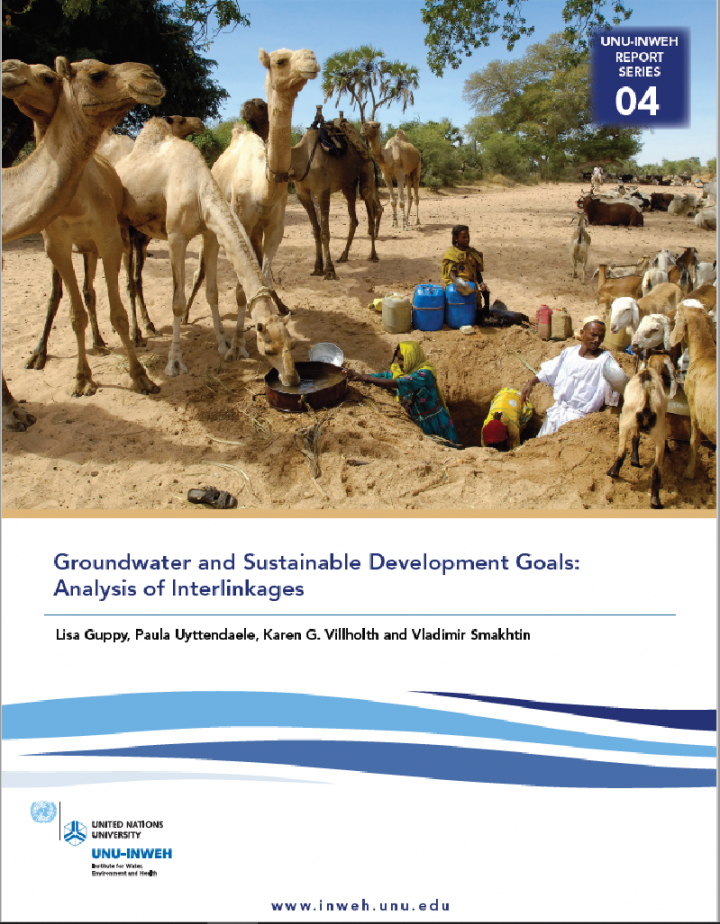Groundwater and Sustainable Development Goals - Analysis of Interlinkages
Guppy, L., Uyttendaele, P., Villholth, K. G., Smakhtin, V. (2018)

Published in: 2018
Pages: 23
Publisher:
Institute for Water, Environment and Health, United Nations University, ISBN 978-92-808-6092-4
Author:
Guppy, L., Uyttendaele, P., Villholth, K. G., Smakhtin, V.
Uploaded by:
SuSanA Admin
Partner profile:
common upload
3319 Views
92 Downloads
Groundwater represents 97% of the world’s available freshwater resources and is extensively abstracted throughout the world. While abundant in a global context, it can only de developed to a certain extent without causing environmental impacts. Also, it is highly variable across the globe, and where it is heavily relied on, it is less renewable. Hence, it is critically important that this resource is managed sustainably. However, the Sustainable Development Goals (SDGs) of the 2030 Development Agenda do not, as a rule, account explicitly for the significant role that groundwater plays and will continue to play in sustainable development. This report aims to unpack and highlight this role through consistent analysis of the interlinkages between groundwater and the targets of the SDGs.
The key features of groundwater relevant to the SDGs are its use, management and sustainability. The methodology used to analyse groundwater interlinkages with SDG targets includes, first, identification of ‘evidence-based’ and ‘logical’ interlinkages. The first type of interlinkages is supported by existing data, while the second is by information and logic that needs to be drawn from existing bodies of relevant research. While only a few interlinkages may be seen at present as “evidence-based”, more data are continuously emerging to make more interlinkages supported by hard-core evidence.
Subsequently, the interlinkages are classified into either ‘reinforcing’, ‘conflicting’ or ‘mixed’ - depending on whether achievement of a target will have predominantly positive, negative, or mixed impact on groundwater. The interlinkages are also classified into ‘primary’ and ‘secondary’, depending on how strong and direct the impacts on groundwater from achieving the targets may be. The report presents a summary of key interlinkages, and subsequently provides the narrative of all ‘primary’ ones.
The analysis suggests that more than half of interlinkages are ‘reinforcing’, while only a few are ‘conflicting’. From a policy perspective i) conflicting interlinkages are the most critical and difficult ones to manage, and ii) it is important to draw synergies between SDG initiatives and groundwater to allow reinforcing interlinkages to materialise. Nearly a third of all identified interlinkages were classified as ‘mixed’. This means that when target activities are planned, careful consideration must be given to possible impacts on groundwater to avoid unintended negative outcomes that may not be evident at first. Primary interlinkages that constitute 43% of all may be the easiest to understand and the most important to plan for. However, there are even more secondary interlinkages. This means that groundwater experts need to be able to share knowledge to a range of actors involved in addressing the targets with secondary interlinkages to groundwater, and vice versa.
It is also shown that i) the importance of groundwater to sustainable development is poorly recognised and captured at the SDG target level; ii) there is a lack of globally useful, up-to-date and SDG-relevant groundwater data available, which makes it difficult to make globally, and even locally, relevant recommendations for groundwater use, management and sustainability in the SDG era, and iii) there are often poor links between targets and their indicators. This may signal that all groundwater-related and groundwater-relevant aspirations may not be translated into real, let alone, measurable action.
This report is not a comprehensive analysis and involves an element of subjectivity, associated primarily with the data and information paucity on one hand, and with the imperfection of the SDG target and indicator system itself – on another. However, even with these limitations, the report shows how significant groundwater is in sustainable development, even if the current SDG framework is implicit about this. Furthermore, it suggests a structured way to improve the visibility of groundwater in the SDG framework as it continues to develop.
Bibliographic information
Guppy, L., Uyttendaele, P., Villholth, K. G., Smakhtin, V. (2018). Groundwater and Sustainable Development Goals - Analysis of Interlinkages. Institute for Water, Environment and Health, United Nations University, ISBN 978-92-808-6092-4
Filter tags
English Groundwater protection (WG11)















